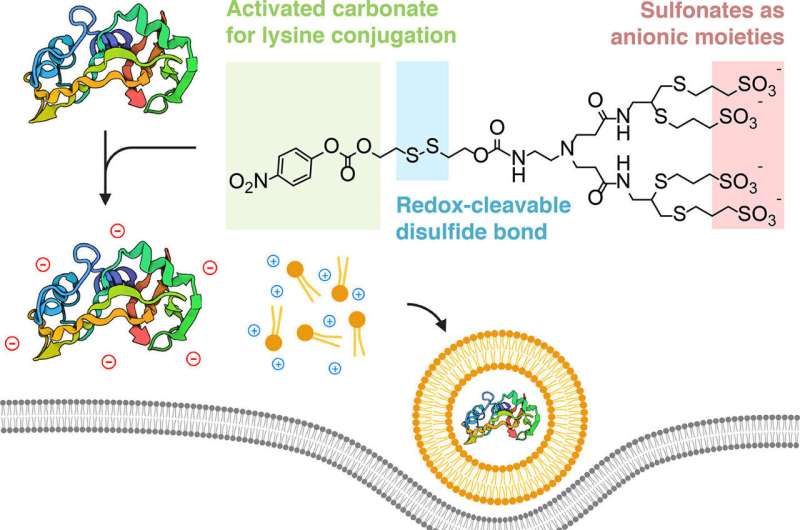This article has been reviewed according to Science X's editorial process and policies. Editors have highlighted the following attributes while ensuring the content's credibility:
fact-checked
peer-reviewed publication
trusted source
proofread
New approach uses 'cloaked' proteins to deliver cancer-killing therapeutics into cells

An interdisciplinary collaboration has designed a way to "cloak" proteins so that they can be captured by lipid nanoparticles, which are akin to tiny bubbles of fat. These bubbles are small enough to sneak their hidden cargo into living cells, where the proteins uncloak and exert their therapeutic effect.
The generalizable technique could lead to repurposing thousands of commercial protein products, including antibodies, for biological research and therapeutic applications.
The group's paper, "Bioreversible Anionic Cloaking Enables Intracellular Protein Delivery with Ionizable Lipid Nanoparticles," published May 14 in ACS Central Science. The lead author is doctoral student Azmain Alamgir, who works in the labs of the paper's co-senior authors, Chris Alabi, associate professor of chemical and biomolecular engineering in Cornell Engineering, and Matt DeLisa, the William L. Lewis Professor of Engineering and director of the Cornell Institute of Biotechnology.
The project began with a singular goal: combining the DeLisa group's expertise in designing protein-based therapeutics with the Alabi lab's focus on intracellular delivery of biologics.
For some drugs to impact a cell's biology, and ultimately treat disease, they need to get inside the cell and reach a specific space. This is similar to fixing a broken pipe in a home: the plumber needs to access a particular room to repair the leak.
Protein-based therapeutics have many virtues—they can have more specific effects, with lower toxicity and diminished immune response—but ease of delivery is not one of them. Proteins are large and cumbersome and don't freely diffuse into cells as easily as small molecules do. That's one reason small molecules are the predominant source of drugs in the pharmaceutical industry: They can easily diffuse into cells without a delivery vehicle.
Over the years, DeLisa's group has developed a wide range of interesting and potentially effective protein drug candidates. Unfortunately, the practical utility of these proteins was limited by the absence of a method for intracellular delivery. While gene therapy—a biomedical technology that can produce a therapeutic effect by delivering a gene for expression in target cells—was an option, the method has a checkered history, owing to safety issues in humans.
"We had been looking for a clever way to efficiently get our engineered proteins inside of cells, especially in a translational context that would not only work in lab-cultured cells, but that would also be effective and safe in animal models and eventually in humans," DeLisa said.
"When Azmain connected our group with Chris's group, one of the ideas that surfaced was, why deliver this as a gene therapy when we could deliver it as an already-made protein? And so that got us really excited."
Alabi's lab had been facing challenges of its own. While the team had experience delivering nucleic acids into cells using nanoparticles, Alabi said, they had yet to find a way to do the same with "globular squishy soft proteins" due to the lab's limited experience in producing sufficient quantities of the proteins for testing.
"We saw this as a nice bridge between our research groups, to create this new space that I don't think a lot of people were working on at the time and do it in a way that could be scalable and impactful," Alabi said.
The researchers had the broad idea of using a bioconjugation approach that would allow the proteins to be loaded into lipid nanoparticles, which form around nucleic acids. A major advantage of this approach was that lipid nanoparticles were a key component in the successful COVID-19 vaccines developed by Pfizer-BioNTech and Moderna.
"At the time, that technology was really taking off," Alamgir said.
Those vaccines worked by delivering a payload in the form of messenger RNA, which are nucleic acids. The researchers now would use the same lipid nanoparticle delivery concept—the same materials even—but with a protein payload. The trick would be to make proteins look more like nucleic acids.
The researchers found they could accomplish this by "cloaking" the proteins with a negatively charged ion, so they would join with the positively charged lipids electrostatically.
"The crux of our strategy is conceptually very simple," Alamgir said. "We're taking proteins and specifically remodeling their surfaces with negative charges, so they look like nucleic acids and can similarly assemble into nanoparticles when formulated with the characteristic lipids."
One difficulty the team encountered was that the conditions under which nucleic acids are formulated to join, or complex, with the lipids are pretty harsh—too harsh for proteins.
"We had to use milder conditions and a slightly modified formulation where we added extra lipids," Alabi said. "So both from the protein bioconjugation side, and also from the lipid side, we had to tweak the formulation to make this work as well as it does."
The team, which included doctoral student and co-author Souvik Ghosal, successfully demonstrated the cloaking method with lysine-reactive sulfonated compounds, killing cancer cells with ribonuclease A and inhibiting tumor signaling with monoclonal immunoglobulin G (IgG) antibodies.
An additional benefit of the bioconjugation chemistry used by the team is that the process is reversible. The chemical tag that is added to the protein sheds off once it has entered the cell's cytoplasm. And because the bioconjugation method targets lysine—a type of amino acid that is abundantly found in natural proteins—the technique can be replicated for practically any protein.
"This has potential to take a lot of off-the-shelf proteins that are currently available from many life science distributors and biotechnology companies and repurpose them for novel intracellular applications," Alamgir said.
More information: Azmain Alamgir et al, Bioreversible Anionic Cloaking Enables Intracellular Protein Delivery with Ionizable Lipid Nanoparticles, ACS Central Science (2024). DOI: 10.1021/acscentsci.4c00071
Journal information: ACS Central Science
Provided by Cornell University




















